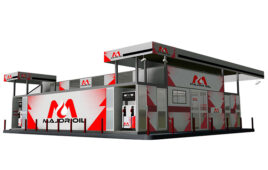Digital trends and savvy service solutions are part of the channel’s future landscape.
 This past April, the global technology and engineering firm Emerson Commercial and Residential Solutions partnered with Euromonitor International to generate research-based insights on the grocery, convenience, foodservice and mixed retail markets.
This past April, the global technology and engineering firm Emerson Commercial and Residential Solutions partnered with Euromonitor International to generate research-based insights on the grocery, convenience, foodservice and mixed retail markets.
Geared toward grocers and restaurants, the report, entitled “Retail and Foodservice 2025: The Future for Customers, Operators and Facilities,” was meant to provide operators a snapshot on changing infrastructure and facility requirements so they can better understand where the market is headed and to begin thinking about the impact to their operations.
Recently, the two organizations collaborated again to provide a deeper dive on the specific areas that convenience retailers should consider in order to adapt their operations to meet future marketplace requirements.
Zandi Brehmer head of client innovation at Euromonitor International and Dean Landeche, vice president of marketing and retail solutions at Emerson sat down with Convenience Store Decisions, to layout future business trends c-stores should take in.
Brehmer said after analyzing various business cases, Euromonitor was able to identity four digital trends that promise to reshape the future of U.S. convenience stores including:
- Evolution at the checkout;
- Inventory and management;
- Mobile opportunities;
- Artificial intelligence shaping the shopping experience.
The evolution of seamless checkout systems will continue to impact the future of convenience retail—to the point the customer experience becomes truly seamless.
“The longer term vision is no checkout,” said Brehmer, who cited Amazon Go as a possible c-store model, featuring futuristic checkout technology. At the end of 2016, Amazon unveiled Amazon Go, a new cashier-less convenience store in its hometown of Seattle that uses artificial intelligence and sensors to track which items consumers take off shelves.
“That to me, that the ultimate future potential stage, where it’s so convenient, we walk in, grab what we need and we leave and store recognizes who I am, what I have grabbed and charges me accordingly,” said Brehmer.
Until that stage becomes reality, Brehmer predicts that retailer checkout will continue to be bolstered by the fact that mobile wallet technology is becoming increasingly sophisticated and more merchants are introducing their own wallets such as Apple Pay.
EFFICIENT INTERACTION
Though convenience remains the channel’s main calling card, retailers count the cultivation of customer relationships as just as important to a c-store’s success.
Shifting the focus on the customer from the checkout to when they enter the store can generate even a bigger payoff. Modern technological systems such as wireless sensors in c-stores can free up staff to focus on higher-value, customer interactions, said Emerson’s Landeche.
As such solutions become more prevalent, Landeche said, the convenience channel becomes more nimble to address the changing needs of its customer base. This includes new retail formats—smaller, fewer redundant systems and more complex, multi-function devices.
Driven by a digital revolution and rapidly changing consumer expectations, convenience operators are devising new strategies to stay competitive and keep customers engaged. As a result, “experiential retail” is a concept that’s becoming more prevalent. As product offerings become more interchangeable, it’s the shopping experience that will differentiate one retailer from the next, said Landeche. In fact, recent studies show that 78% of U.S. millennials would rather spend money on a desirable experience than on the goods being sought.
In addition, c-stores should consider the omnichannel proficiency of their operations. More retailers now are integrating their car wash controls, fuel pump monitoring and food equipment capabilities to maximize efficiency, including managing various operational systems through one central point of control, Landeche said.
FUTURE ENDEAVORS
Not surprising, better inventory management will also distinguish successful convenience operations in the future, said Brehmer. Not only does new technology enable retailers to track inventory, but to learn who’s buying what.
“The ability to have a real-time tracking and updates on what’s happening with inventory, and even looking at the data to track and know when will the ebbs and flows of needs change across categories and who’s coming into my store (is noteworthy),” said Brehmer.




